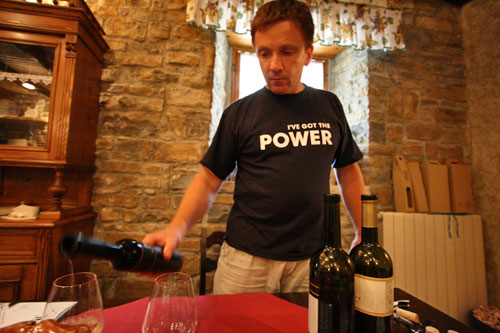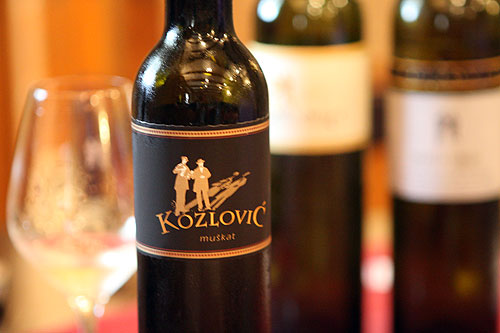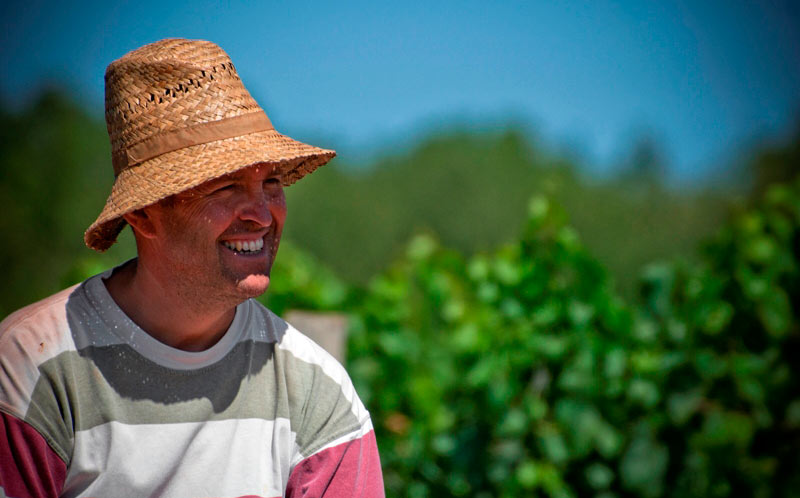
This is an article from our archives that was previously run on another site in August, 2007.
The last stop on our whirlwind tour of Istrian wines was Kozlović. The location that the family has settled in is spectacular one, near the village of Momjan. While the village is typical of the type you see in Istria, it has a nice standout feature which is the ruins of a fortress up on a hill. Like something out of medieval fairy tale, this stony skeleton floats about the small valley where the family built their current cellar in 1904 on a hill, overlooking some of their vines.
Even when you strip away the setting and just focus on the wines, you see that this is a family that knows what it is doing when it comes to the grape. Their Malvazija can be gotten here and is getting to be recognized as a quite stellar take on this Istrian varietal. But there at the helm of everything is Gianfranco Kozlović. He is a character who loves his wines and loves the process of making wines.

His various philosophies and ideas about wine are one of the few drinking companions that are better than a well-cured pršut. For instance, he really wants to stay with the native varietals that grow in the area, but he isn’t afraid to try a little Shiraz or Cabernet Sauvignon to see what happens. He likes to age his in Malvazija in acacia barrels (which is traditional), but he’ll also try aging other wines in acacia to see what the result is. He finds barrels to work very well with reds, but thinks that the whites should only be touched by them for a bit of spice and toast.
He is a big believer in the new technologies that make wine production more easy to control, since while producing the old way is fine, why do it if there are better ways? And our favorite idea of his is that after you’ve finished experimenting, you really need to go back and ask yourself what is it that you like to drink and enjoy. It is this line of thinking that made their very clever logo come about (two friends drinking together), which Gianfranco sees as a symbol of the pleasure of drinking, friendship, and the moment of the toast.
Once we worked through the thinking behind the wine, we learned that Kozlović is producing 100,000 bottles a year and he is fortunately looking to export more, which is good news for us. His production is mostly white, with that taking up about 80% of his bottles and the other 20% of red being comprised of Teran (Refošk).
It was 15 years ago that they started as the business that they are today and in 1998 they built a new addition on to the original cellar that is now over 100 years old. They have been growing in other ways too. Just three years ago, they were producing from just three hectares. Today, they cull their grapes from 16 hectares. While they are looking to have much more land, this has been difficult due to the political issues (yes, even wine is political) and they are looking to get their grapes from a focused 25-30 hectares in order to maintain a consistency to the wine, which is always appreciated by we drinkers.

We started with the 2006 Malvazija which is the core wine the Kozlović production. The nose has this nice, soft, lilting grapey set of aromas to it. The body is bright and tones of grapefruit come through on top of everything else. The finish is nice and smooth.
There is dryness, but it works wonderfully to refresh you. As described elsewhere the color is really lovely on this wine. It’s a nice, pale, beckoning yellow that sits well in your glass on a hot day.
We then moved in to the 2004 Santa Lucia. This is a Malvazija that has a great meaty nose that speaks of pršut, the ham that they eat with great abundance in Croatia. There is light fruit throughout it and a touch of sweet melon aromas as well. It is an incredibly fresh wine, bright and like a meal for the nose. The wine is mixed with 10% of it aged in local oak barrels and the other 90% not aged, so a light balance is achieved with the wine not getting overly woody, but still having a bit of oak spice to it. As you get more air in to it, some honey tones come about in both the nose and the body, which all get stitched together in a nice clean finish.
Gianfranco next poured us the 2006 Muškat. The nose is sweet, but not unduly so and is fitting given that the wine is classified as a half sweet wine. It has a nice leafiness to it and is crisp on the tongue and finishes up well. There is a light sweetness to it that falls down the back of the mouth. We were told the thinking behind the wine was to have a Muškat that could be drank with the meal instead of just once finished as it is usually had.
Next was the Ruža Rosé which is classified only a ‘stolno’ or table wine. It goes to show that you can’t pick what you want to drink based solely on a classification for the wine is really very good. You almost can’t detect the nose, it’s so soft and subtle. There are very delicate peach tones throughout the entire wine. A tad bit of almond comes across the top with more air. The body is very dry, but has a pleasant hint of sourness to it that works very well. In the finish, it slides back very easily. It’s a very refreshing wine that is a quintessentially perfect end to a meal.
We closed with the Dolcinea. Like the Ruža Rosé, it is also a ‘stolno’ level of wine. It also happens to be a late harvest wine, which means that there is a good deal more sugar in it. Despite this, you are not punched by a glass of sweetness. It is conscientiously delicate and delicious straight out of the bottle without getting a breath of air in it. The nose is this soft, blushing bouquet of aromas with hints of sweetness that all come in the body. It is a very clean wine and refreshing. Again, another perfect wine to finish a meal with.
It was quite a line up of wines that made us thankful we were very close to home after drinking. Gianfranco and his family are making some excellent varietals up in the north and their plans for expansion are both well-balanced and also very fortunate for us as we will hopefully get more of their wines here in the future. For now, try the 2006 Malvazija if you haven’t already. It’s a wonderful example of how well a white wine can be made.
